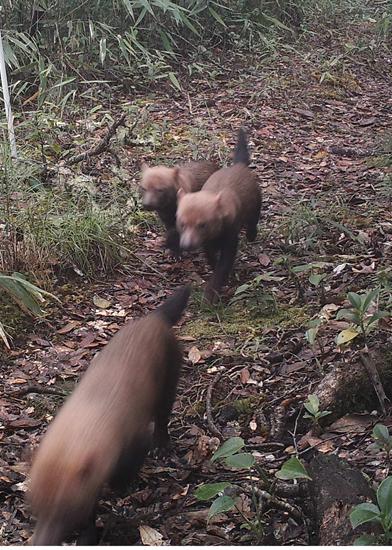Trail cam documents unexpected, most northerly sighting of pack-hunting canids

Credit: Point Loma Nazarene University/Michael Mooring
AMHERST, Mass. – Wildlife ecologists at the University of Massachusetts Amherst who are studying different conservation practices in the forests of Costa Rica recently made a startling discovery on a wildlife camera trap – wild bush dogs documented farther north than ever before and at the highest elevation.
Doctoral student Carolina Saenz-Bolaños is in Costa Rica comparing land use, management techniques, their effects on species presence and abundance, and human attitudes in four different areas in the rugged Talamanca Mountains: a national park, an adjacent forest reserve, an indigenous territory and nearby unprotected areas.
She and her advisor, professor of environmental conservation Todd Fuller at UMass Amherst, with others, report in an article today in Tropical Conservation Science the new, repeated sightings of bush dogs (Speothos venaticus) on trailcams well outside the limit of their previously known range on the Costa Rica-Panama border. The dogs are native to South America but are considered rare and are very seldom seen even there, the two ecologists point out.
Fuller says, “They aren’t supposed to be there, but Carolina’s work shows they really are, and they seem to be doing well. Not only is this wild dog rare wherever it is found, but this mountain range is very remote, with very little access. They could have been there before and we wouldn’t know it. So we’re documenting them with this report.”
Saenz-Bolaños says that because the roadless area is so huge, she and colleagues are not sure if the dogs are expanding their range, returning to a former range, or if they’ve been there all along but eluded detection. She works with Victor Montalvo, a fellow UMass Amherst doctoral student, and Eduardo Carrillo of the Universidad Nacional de Costa Rica and UMass Amherst adjunct professor of environmental conservation.
Once the dogs were spotted on camera, the researchers contacted Michael Mooring of San Diego’s Point Loma Nazarene University who, with Junior Porras of Costa Rica’s National System of Conservation Areas (SINAC), also had obtained new bush dog photos from southern Costa Rica.
Saenz-Bolaños, who has been operating trap cameras in the area since 2012, says, “I know most of the things that live here, so when I saw them on the camera I said ‘Wow, what is that – bush dogs here?’ I was very excited and thrilled to see them.” She adds, “The native people have a name for these dogs and their oral tradition says the dogs have been there in the past, but people living there now have never seen one.”
Bush dogs have been spotted north of the Panama Canal near the Costa Rica border in the past 10 years, she adds, but they are completely unexpected in the northern parts of the Talamanca Mountains.
Fuller says that bush dogs have lived in South America for thousands of years, and no one knows why they have not moved farther north into Central America, where the habitat is similar, but they are so rare that studying them is quite difficult. “There are still definitely interesting things to find out about them, especially if they’re expanding their range,” he says.
Curious about what it would take to collect more sightings of bush dogs in Costa Rica, he and Saenz-Bolaños worked with Paul Sievert of the U.S. Geological Survey and UMass Amherst to calculate how many camera-trap hours it might take to have even a 50-50 chance of seeing the animals again in an area of roughly 2,000 square miles (5,000 sq. km). Fuller says they estimate that it would require at least 25 camera traps set out for 100 nights, a difficult task in such remote, mountainous and tropical terrain.
The ecologists hope that their report will spark the imaginations of other wildlife ecologists, park managers and rangers in the region, who might set up their own camera traps in promising areas. Saenz-Bolaños plans to continue monitoring her study area and plans to try to talk to more local people about the dogs. Fuller adds, “At this point the mountain range looks like good bush dog habitat, but we just don’t know if they are getting started there or are already at home.”
The Stone Zoo in Stoneham, Mass., part of Zoo New England, has a family of bush dogs on exhibit where visitors can see these small wild dogs. The zoo participates in species survival planning for the bush dog to manage and conserve threatened or endangered animals.
###
Media Contact
Janet Lathrop
[email protected]
Original Source
https:/
Related Journal Article
http://dx.




